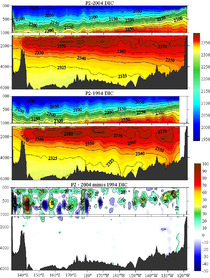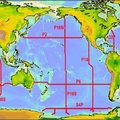P2
The immediate goal of the "P02" expedition was to carry out a trans-Pacific transect along 30°N, angling north to Japan and California at the ends. This was a repeat of the WOCE-era "P02" transect, carried out via four 1993-1994 cruises led by Japanese oceanographers. The principal program of measurements was reference quality CTDO casts with bottle sampling for salinity, oxygen, nutrients, a host of carbon parameters, CFCs, helium and tritium, and radiocarbon, plus a suite of underway measurements, as part of the NSF and NOAA supported US Global Ocean Carbon and Repeat Hydrography program. There were also CTD/rosette casts with separate equipment for an NSF-funded trace metals program, ARGO float deployments, and plankton tows for an SIO investigator. The R/V Melville departed Yokohama, Japan on June 15, 2004.107 LADCP/CTD/Rosette stations and 52 trace metals casts were completed before arriving in Honolulu, HI USA on July 25, 2004 for the end of leg 1. Leg 2 departed Honolulu on July 28, 2004 and completed 82 LADCP/CTD/Rosette stations and 38 trace metals casts before arriving in San Diego, CA USA for the end of leg 2.
Carbon Data
CTD and other hydrographic data
WOCE section designation: P02
Chief Scientists: leg1: Paul Robbins and Andreas Thurnherr, leg2: James H. Swift and Dong-Ha Min
Dates: 15 June 2004 - 27 August 2004
Ship: R/V MELVILLE
Ports of call: leg 1: Yokohama, Japan - Honolulu, Hawaii, leg 2: Honolulu, Hawaii - San Diego, California
stations: leg 1: 107 LADCP/CTD/Rosette stations, leg 2: 82 LADCP/CTD/Rosette stations
Geographic boundaries: 29°57.27'N to 32°44.94'N by 133°6.73'E to 117°23.03'W




